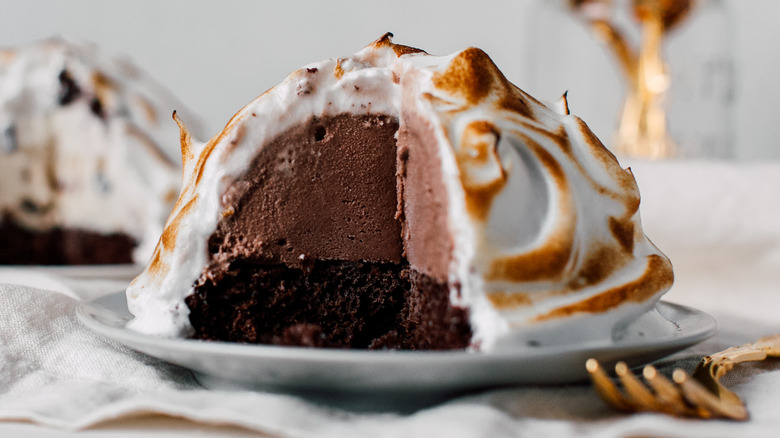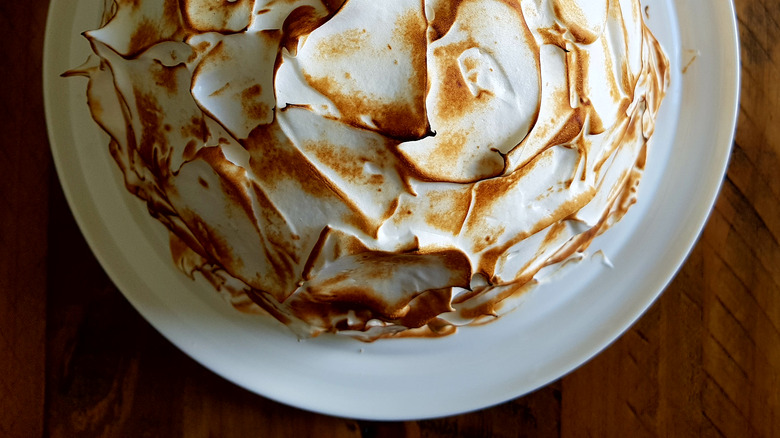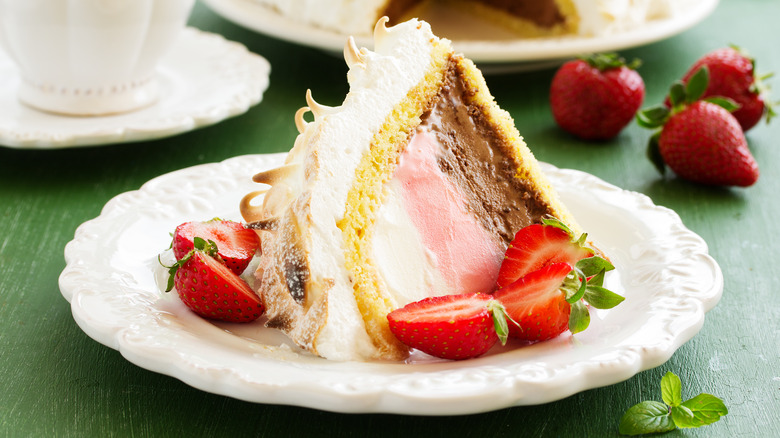Why Doesn't Baked Alaska Melt?
Baked Alaska is a magical dessert. Not only does it look like something out of a Dr. Suess book with its scorched, sky-high meringue peaks, but that it's also an ice cream cake underneath all that fluffy drama makes it an undeniably fun dessert as well.
That said, the history of such a whimsical treat isn't exactly clear. Some versions of Baked Alaska have been around since the start of the 19th century, with many early versions featuring pastry on top of the ice cream instead of meringue (via Culture Trip). In fact, it's reported that Thomas Jefferson was the first U.S. president to serve ice cream to White House guests — and that he did so with a pastry-topped version of the dish.
At the time, Baked Alaskas were the newest and neatest desserts around. The International Dairy Foods Association explains that Americans had only been enjoying ice cream widely since the very beginning of the 19th century, so the idea of mixing ice cream with heat was previously unheard of.
Nowadays, Baked Alaskas are most commonly associated with retro recipes from the 1950s. Even so, most people don't actually know how Baked Alaskas work — not to mention how all that meringue and ice cream doesn't melt after popping it into the oven. So how does this dessert balance such disparate temperatures without devolving into a sticky sweet disaster? Spoiler alert: It's not magic, but science.
The science behind meringue used for Baked Alaska
Not only does the ice cream in a Baked Alaska not melt while it's baking in a hot oven, but the meringue on top of it doesn't turn into a pile of goop either. How is this possible? According to the outlet Popular Science, the whipped egg whites in the meringue act as an insulating agent. On top of that, the proteins found in egg whites, along with another ingredient, cream of tartar, help the meringue retain its structure and its heat-resistant barrier. In this vein, the thicker the meringue, the better its heat-resisting properties.
There's no doubt that the key to a successful Baked Alaska lies in a well-executed meringue topping. If your meringue melts into a gooey mess the second it hits heat — or never really takes shape to begin with — chances are that your ice cream is going to be exposed to more heat than is ideal. When whipped up correctly, a good meringue baked at low heat can result in a sweet, airy treat with a bit of a crunch.
Why a Baked Alaska works
When it comes to Baked Alaska, the temperature of the ice cream is just as important as the meringue which actively insulates it. Generally speaking, it's recommended that the ice cream should be very, very cold at the time that the dessert is placed in the oven. That means that after molding the ice cream into the cake pan, it should be frozen for a minimum of two hours, but ideally overnight. This way, there's no real possibility that the ice cream will be negatively affected before it goes into the oven by either handling or room temperature (via Comsol).
The shape of a Baked Alaska can also play a role in its success as an ice cream cake. There are different varieties of Baked Alaska, but a globular form seems to be the best approach for most cooks. For example, if you make a Baked Alaska in a glass pyrex dish and simply layer cake, ice cream, and meringue on top of each other, the ice cream's edges aren't completely protected from melting. On the other hand, according to the U.K. Mirror, using the meringue to form a round encasement around the ice cream and cake creates a seal that's difficult for heat to penetrate.


